Motor pulley sizing is a complicated topic that can commonly be misunderstood, yet it is so important to get right. This article will provide you with a background on its importance and the math behind pulley sizing, followed by a useful thread on the topic!
Table of Contents
- Why Is It Important to Size Pulleys Properly?
- The Math Behind Pulley Sizing
- Worked Example: Help With Size and RPM for This Air Compressor – Thread
- FAQs (Frequently Asked Questions)
Why Is It Important to Size Pulleys Properly?
For air compressors and all applications that use motors, as a matter of fact, it is critical that pulleys are sized correctly to ensure that the correct RPMs (revolutions per minute) are maintained.
RPM is essentially the speed that determines a pump’s flow output rate – in gallons or liters per minute or cubic feet per minute in regard to air compressors. Incorrect pump RPM will adversely affect the pump performance – if it turns too slow, it will not perform at its best. In contrast, if it turns too fast, it may cause premature wear.
Therefore, this justifies the critical importance of ensuring correct pulley sizing on any motor or drive unit relative to the pump.
The Math Behind Pulley Sizing
The formulas for determining pulley ratios are complex, but in generic, more layman-like terms, you can simply divide the pump’s RPM by the motor’s RPM to get the required pulley ratio.
Example 1:
Let’s say we have a 1250 pump RPM and a 1750 motor RPM.
Pulley ratio = 1250/1750 = 0.714
Therefore, the pulley ratio must be 0.714 for the pump to operate correctly. Now, this pulley ratio can be used to calculate either of the pulley sizes if you have the other.
Example 2a:
We have a 5″ pulley on the pump.
Motor Pulley = 5″ x 0.714 = 3.57″
This means the motor pulley must be 3.57″ in diameter to run the motor at its specified 1750 RPM.
Example 2b:
We have a 5″ pulley on the motor.
Pump pulley = 5″ / 0.714 = 7″
This means the pump pulley must be 7″ in diameter to run the motor at its specified 1250 RPM.
These examples are oversimplified and use random numbers to give you an idea of the math that goes into sizing a pulley. If you wish to dig deeper into the understanding of how to size a pulley, I recommend researching more technical publications on the matter online.
Worked Example: Help With Size and RPM for This Air Compressor – Thread
This was a long thread that started when Zain sent in a request for help with the size and RPM required for an older air compressor. His initial post was in early October 2019 and he asked:
“Please help me identify this compressor pump. I am interested to know what size and RPM motor I need for it as well as recommended oil and capacity.
If I only knew the manufacturer, I might be able to research the rest of the information on my own.
The only numbers on it appear to be “070B” with no other markings. It looks like it also has a red oil fill cap on top, and a black vent near the middle/back of the pump, below the oil fill port. The darn data tag is gone off it, purchased from a moving sale for a very decent price.”
Photo 1: Zain’s compressor pump, sheave side right:
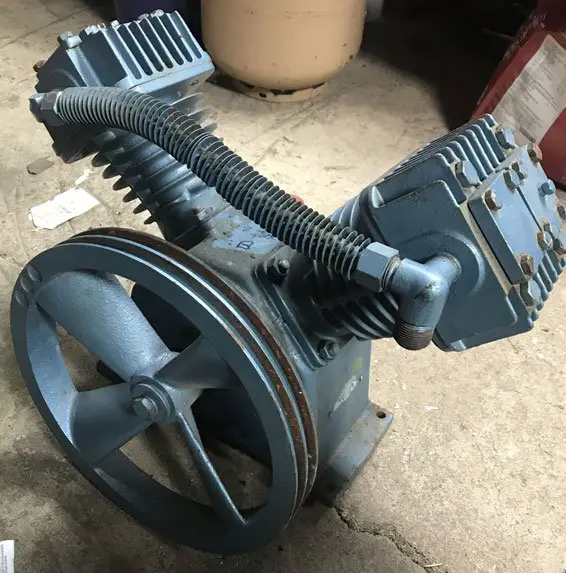
Photo 2: Zain’s compressor pump showing pump sheave size:
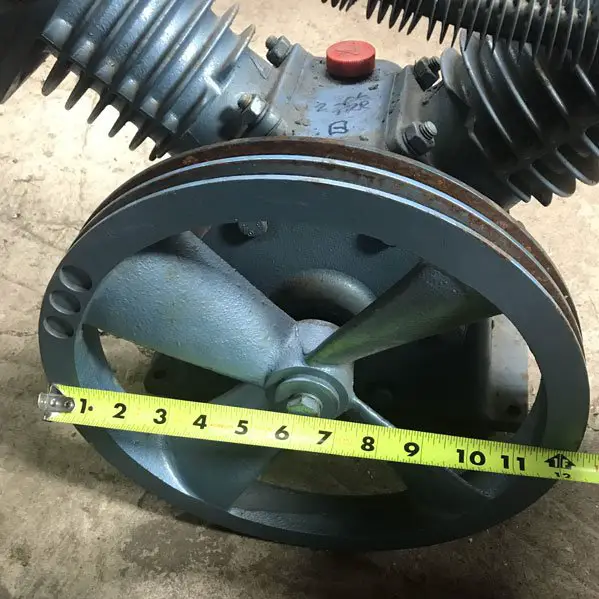
Photo 3: Second cylinder on the pump:
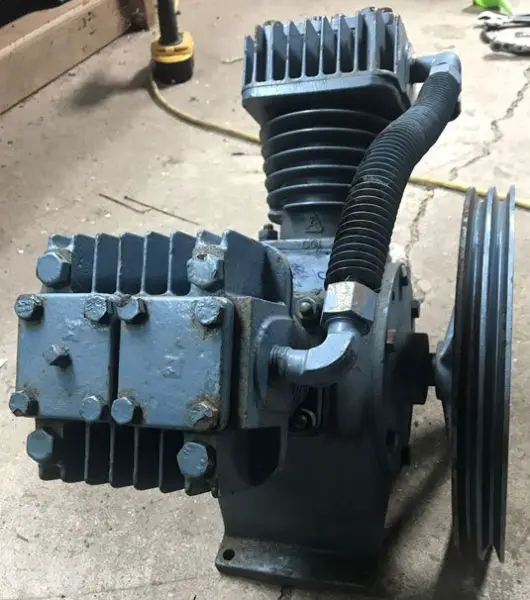
Photo 4: Closeup top of cylinder right:
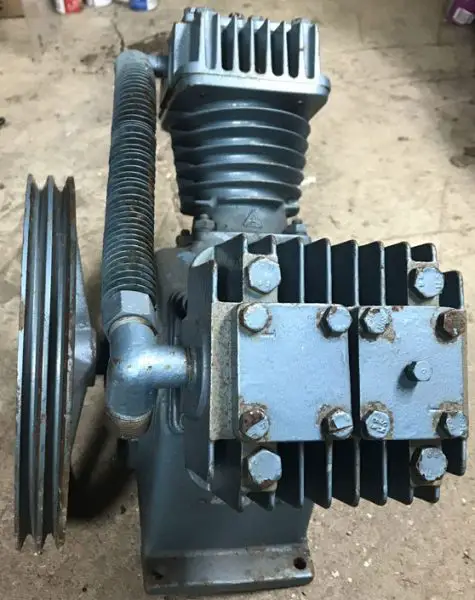
Photo 5: Closeup of the number on pump housing:
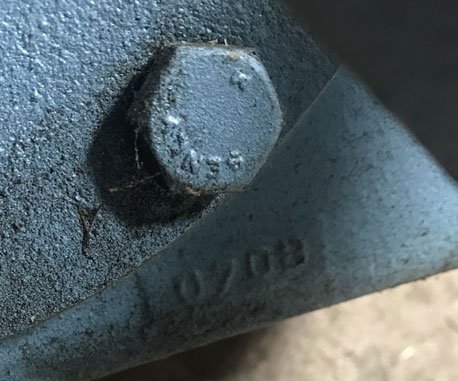
Troy contributes:
Almost immediately Troy contributes, saying that Zain’s pump is a “Curtis challenge air (and he) would need to know the bore size to give you the right model#. I’m guessing but it could be an es-30, hopefully, this will help you, don’t get confused on the parts break down as it shows a 3 cylinder, you must look at the correct column for each model to determine the parts.”
Troy provided the following photos:
Photo 6: Zain’s compressor parts listing:
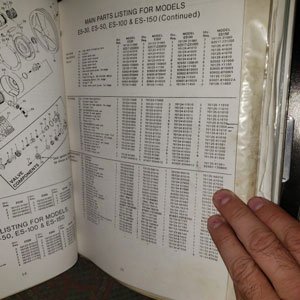
Photo 7: Parts exploded view:
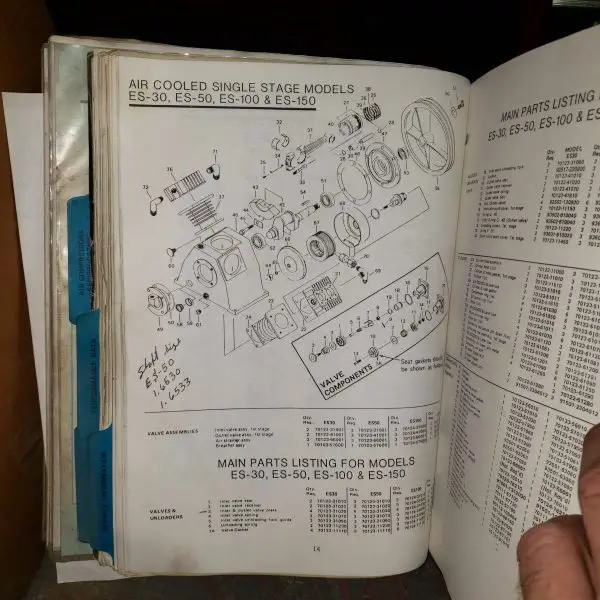
Photo 8: Performance data:
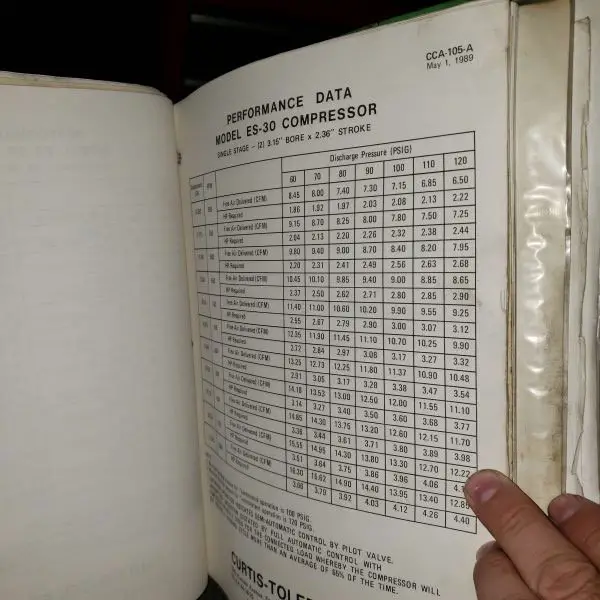
Zain’s response:
“You sir, are amazing! Thanks for the info! Looks like I need a 3HP motor that will spin this 800 RPM. Probably a standard air compressor-rated motor, 3 HP 3450 RPM. Any chance that you have the oil viscosity and amount requirements in that handy manual? There isn’t a viewing port on it. Thanks again!”
Troy’s response… “I would go with a 3hp 1800 rpm as that is what they used from the factory or you could use what is called a cheater motor which would be 3450/3600 rpm 22.5 amp rated.
Use non detergent 30wt sae compressor oil.
To figure out what size pulley you need take the flywheel o.d. size and divide –
- example 12÷2.75=4.36
- then take the 4.36 ratio and divide it into the motor rpm 3450rpm.
- This will give you the compressor rpm 3450÷4.36=791.28 rpm.
If using a 1750/1800 motor then…
- example 12÷2.75=4.36, then 1800÷4.36=412.84 rpm
- big pulley ÷small motor pulley = ratio
- then motor rpm÷ratio= compressor rpm
Hope this helps
Es30= 1 quart oil capacity”
Photo 9: Oil information

Zain added to his questions:
“Any idea what size and type of nut I will need to connect tubing at the highlighted point on the attached picture? I believe it to be a 5/8 tube? Would copper be acceptable when going from compressor to tank? Thanks”
Photo 10: Location of connection nut
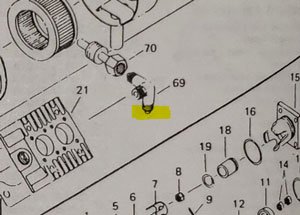
Long time adviser Doug from San Diego contributes:
“Copper is good if you have or can find it. Take it with you to a big box or real hardware store to check the threads.”
Troy responds with:
“Well, glad to hear you can do the amp draw, it should be fine for the low usage, you got a great deal for $40.00 on that pump. New from Curtis it’s above the $650.00 range.
If you need parts I am a Curtis distributor, along with Saylor-Beal, Schulz, Atlas Copco, c-p, Claire, champion, puma, Emglo/jenny, Davey, American eagle formerly e.l. smith.
Also, deal with lines that have been bought out or are no longer in business, Worthington, joy, Multi-quip, Grimmer Smidht, p.k. Lindsay, Brunner, Globe, Par, Keystone compressor, United States air compressor, Leroi, Kellogg, Wabco, Westinghouse, and many more, Ingersol-rand, Sullair, Sullivan, Doosan, Sullivan, and Godwin pumps from England, Bendix air brake, Haden. Airman. I work on them all and in Oklahoma, with the oilfield, we modify and make a lot of parts for the obsolete pumps of the past. I even have a line of our own we call the T-REX.
You will need a tube nut and yes you can use soft roll copper and then flare the copper tubing, I have seen where some will get a pipe coupler and install it on the fitting then use an NPT × compression fitting. If you have a hose manufacturer around you they should be able to supply the tube nut, I will check to see if I can find the size and inform you.
This should help you, it shows a 3/4 o.d. discharge and thought you would like to see a new cost of an es30 pump. If you have an issue with finding a tube nut locally you can always remove the discharge fitting and install a pipe nipple with a black pipe tee then install compression fittings, just cut the flare off the line that goes to the discharge flared fitting, remove the item #69 and install a nipple x close the new tee and add your compression fittings and run your new discharge soft roll copper line to your check valve.
You should be able to find soft rolled copper at the HVAC supply house or if you have a friend in heating & air I bet ya he will have some you can get. Also, you can get a 3/4 black pipe collar and install it on that discharge fitting and add a compression fitting for your new discharge line.”
Photo 11: Drawing of ES 30
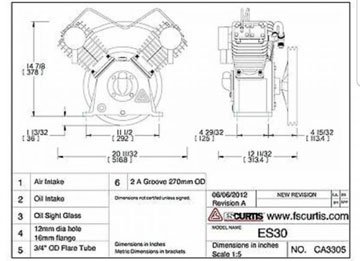
Photo 12: Price of new ES30
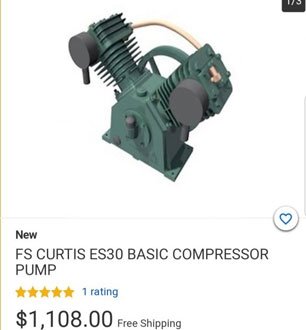
Troy comments on the motor:
“You are welcome Zain. Another thing most home-style units use the 3450/3600 electric motors as they are cheaper to buy, and the industry unit uses 1800 rpm electric motors, the weg is a good 3450/3600 rpm electric motor, as for 1800 motors we use Baldor, lesson, marathon.”
About the motor, Zain responds:
“So I bought a motor before you guys responded, maybe I jumped the gun. It’s a 5hp Leeson (SPL) rated at 15-16 amps, 3450 RPM. Will I be okay or should I cancel and order something else? Thanks again, men!”
Troy says:
“If I was you I would cancel and get the 3 or 5 hp 1800 rpm motor, it will be better but will cost more. Now, that being said if you want to stay with the 3450/3600 step up to the 22/23.5 amp motor that has the 7/8″ shaft. It will pull your pump. It is less than the 1800 but more than the spl=special 15 amp 3450 rpm.
eBay has the weg 1800 rpm and the century b384 3450 5hp special motors. Now make sure you sheave the b384 motor for a 3hp as this will work fine, but if you want the 5 hp performance I would not recommend using that motor with your pump. If you want 5 hp performance then go with the weg 1800 rpm motor as it is a true 5 hp motor.”
Photo 13: Recommended motors
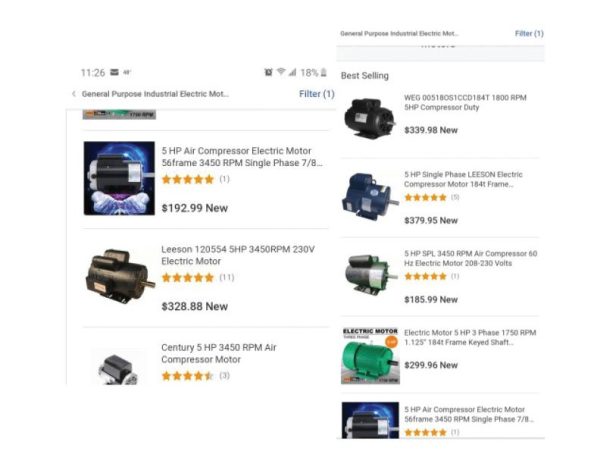
“If you go with the 3450rpm motor b384 it will be 230-volt single phase. Make sure you have a 25 amp breaker and your pulley size would be 2.75 inches which will set your compressor rpm at 791 or 2.90 inches with that motor will set your compressor speed to 835rpm which you should be ok.
You will need a check valve which is required on all compressors there are two styles an in-tank or an inline size to the discharge port size, most use the in-tank style, also on the check valve you will need the 1/8″ bleeder port which you will need a 1/8″npt x 1/4″ compression so you can run a 1/4″ copper line to your pressure switch and that switch will need the bleeder valve on it.
Make sure to attach the 1/4 copper to your check valve to your pressure switch as the check valve allows air to flow one way into your receiver tank. The bleeder valve, when it reaches the final pressure of 125 psi, will bleed from your check valve up to the pump to zero. This allows your motor to get up to the full rpm to pull your pump and not start up against a load that will harm your motor. Mandatory.
If your tank doesn’t have a place for the in-tank check valve then you can go with the inline style with will have two female in and out ports. Also, make sure your receiver is rated to 150 psi or up to 200 psi.
And you will need a relief set at 150 if your tank is rated at 150 working pressure. If it’s rated at 200 psi and because you have a single-stage pump that will produce up to 125/150 psi I would recommend still using a 150 psi relieve valve so your pump doesn’t get damaged in the event your pressure switch contacts were to weld. Safety first and always.
The relief is mandatory and like I said if the pressure switch was to weld/stick then this valve will pop off at 150 psi and keep the tank from an explosion.
On your tank, it should have a tab welded to it showing you the rated pressure or w.p.=working pressure. All single-stage compressor tanks are rated at 150 mwap= maximum working air pressure and all 2-stage compressors will be rated a 200 mwap as a 2-stage with going up to 175 psi.
Bill says:
Zain, further to Troy’s comments, there are pages on this site that provide lots of information about the tank check valves, the unloader valves, etc. along with photos.
Zain:
“Thanks, Troy. So that Leeson 5HP SPL motor has already shipped so I will not be able to cancel it at this point. The link for the motor I purchased is below. Is this motor going to be an issue for me? I was thinking that the 5HP rated at 15 amps would be okay to replace a 3HP at 22 amps. Is my logic not right here?
I actually have a nice 60-80 gallon tank that I’m picking up from my uncles this afternoon. It already has the pressure switch and PRV on it.
Also, I snagged a 2.6″ pulley last night for that motor as well. I tried to do the math that you gave me above to determine which size I needed for 800 RPM.”
Troy:
“The 5 hp rated at 15 amp is really only a 3hp motor and that’s the reason they hang spl=special, the sticker shows 5 hp but when you look at the amps it is only a 3hp motor which is most commonly found in home use/ big box store compressors. Now the 3 hp rated at 22 amp is a stronger motor which would be the b384 motor which has the 7/8 shaft and is also used in the home use they will state it can be a 4.5, a 5 hp, 5.5, and a 6.5 hp motor we call them a 4.92 horsepower motor they are shy a few amps for a true 5 hp and whoever uses them states spl= on them, as well on the tags the tanks will display 6.5 horsepower but the motors never will show the horsepower if that makes sense.
So the motor you purchased may pull your pump it will struggle if it makes it to 125psi final pressure. Best to do the 22 or 23.5 amp b384 230v 1phase it will pull your pump to 125psi final pressure.
As for your 2.6 pulleys, your rpm will be 748rpm for your compressor.
You can try the motor you purchased and see if it will pull your pump, if not then you can get the 22amp 230v 1ph b384 with a 7/8″ shaft. And use a 2.75 or up to 2.90 motor pulley. If you have an electrician friend you can have him do an amp draw in your motor to see what the amps are when starting and to kick off to final pressure that will show you if you are over amping and must change to the bigger motor.”
Zain:
“Thanks for all the great info. I am just a home user with side projects at the house once in a while. I can do an amp draw on it myself and determine if I should upgrade the motor from there. From what you’re saying, I’ll probably be fine for that 2-3 times a year I need a compressor. FYI, I paid $40 for this pump, a good deal or what?
Well. You were right! This 5HP SPL is an SPL POS. It will not start the pump again when the tank is charged and in use.
I opted for the WEG, 1750, 5HP, and a 5.45” 1-1/8 bore pulley. If this doesn’t do it….grr.
Wonder what I’ll do with this SPL now…
Thanks for the advice…you guys know your shit.”
Doug asks:
“I don’t know that that’s a valid conclusion. Are you sure your tank check valve and unloader are working properly? What happens, exactly, when it tries to restart?”
Zain:
“Doug,
FYI, I was about to post this on another location of this website but I’ll respond here.
The pump starts fine when the tank is empty. It tries to fire up again at the cut-on pressure but struggles until it eventually trips the overload or breaker. It’ll get a couple of rotations and that’s it. Also, I have to COMPLETELY drain the tank to get the pump to start again.
For the check valve and unloader components, could you please elaborate or point me to a source that explains how either of those being faulty would cause this issue? I assume that if the check valve is not opening up enough while there is pressure downstream of it, it may cause my current issue? Does the unloader appear to be working? I do hear air hiss out after the motor turns off. The pressure switch is pushing the stem in and releasing air. These components are both parts of an older 1983 tank. The line on the unloader is very small.
While it is running, I occasionally hear a knock. Unsure where it’s coming from, but it sounds like it echos in the tank.
Thank You, Gents!
– Zain”
Doug:
“https://www.about-air-compressors.com/tank-check-valve/ – for one.
The combo of the check valve and unloader is supposed to give the motor a short time to get up to speed before the back pressure load comes into play. Maybe you could post a pic or three of what your setup looks like now. You need a certain amount or more of volume between the pump and the check valve so the pump gets to speed before the pressure builds there. What’s the calculated RPM of the pump as you have it set up?”
Zain:
“The outlet of the pump is about directly above the tank inlet so there is only about 4″ of 5/8″ copper line that steps down to about 8″ of flexible 1/2″ line between the pump and tank. The calculated RPM of the pump is 794.”
Doug:
“So about 12 inches – could you make it longer, or add volume some other way without a lot of trouble?
and
‘ “I have to COMPLETELY drain the tank to get the pump to start again.” ‘ Hmm. Are you sure it won’t start with say 20-30 psi in the tank?
And finally, have or can you check the voltage at or near the motor when it’s off, running, and trying to restart? You should probably verify the voltage before anything else.”
and…
“That should be fine if you have the pulley and power for it. Sounds efficient, if that’s at 220. Troy may have other knowledge…”
Troy:
“Zain what is your start-up amp draw first of all then we need the amp draw when it shuts down? If the amps are higher than rated in the motor then your motor isn’t big enough to pull your pump on startup.
The weg 5hp motor with 1750rpm will pull your pump, you will need a 30amp breaker which is required for a 5hp motor.
How to check and see if your check valve is failing? Two ways. The first is the bleeder switch (valve) on the pressure switch, if it bleeds all the time after it shuts down that is a sign the check valve has failed.
The second way to check the check valve is to loosen the discharge line and see if air escapes from the valve (and) if none with a line off then I put my thumb over the inlet side to see if it has a minor leak which will cause back pressure and will cause the motor to struggle to get up to full rpm.
The SPL motor you bought is used in what we call cheater pumps, big-box store type of compressors. You should be fine with the 5hp 230v 1ph 1750 weg motor, still do an amp draw on startup and final pressure and when it restarts so you can see your amps. Make sure you have a full 230 volts incoming power, if you have a y-type voltage and it’s around 208 then you should be good, but if it drops below 207.9, and stays above 190 volts then you must use a 200-volt motor.
Now let’s say you have 208 up to 240 delta voltage you will be fine with the weg motor. We in Oklahoma have started running into the y and delta power being supplied in the last few years. Delta is a better or shall I say industrial power, y is for convenience stores, strip malls, and home usage.
Hope this helps, let me know how all turns out for ya.
Additional comment from Troy:
Zain, with your 5.45 pulley and your weg 5hp 1750rpm motor you will only be using 3.54 hp in your motor, you can always go up to 1,000 rpm, and still, you will use 4.40hp in your weg motor. Personally, I would stay around 950 rpm on the pump with your weg if I was building. I don’t like going over 1,050 rpm when a pump has a disc and spring valve system. It’s hard on that type of valve, if a reed and built right then they can run much higher RPMs and not be affected, the example was Worthington and Brunner pumps, But they were designed right.”
Response from Zain:
Hey there, again, thanks for the great info! I didn’t want to go over the max RPM that was specified for this pump. I am required to use a generator at this point to power the compressor as I don’t have 240 in my garage and am unsure of the power type.
I actually have been having fun building this. I ended up picking up some C12x30 and a motor base. Going to separate the pump assembly from the tank. This will also allow for longer space between the pump and tank as well to hopefully help with pump restarting issues. The pics below don’t show the base yet but I’ll have more to come. Hope you don’t mind if I share the complete build!
Doug, in reply to Zain:
Zain said, “Hope you don’t mind if I share the complete build!” Not at all – keep ’em coming! It’s your page, after all.
Zain, in reply to Troy:
Ok, so I have some developments. Please see my progress (photos) below, I’m please with how the build is going, minus the shipping damage on the motor.
I installed 2 A74 belts on it, tensioned at or about 3/8” to 1/2” deflection at 5 lbs pressure. There is also about 20 feet of line between the pump and check valve.
The pump now just spins slowly until it trips the breaker. I see the voltage (being supplied from my generator) drop from ~250VAC down to ~90 and even one time I tried, down to about 60VAC. Not much pressure is built up in the line between the pump and check valve – I manually bleed it off at the pressure switch.
Please continue to educate me on this some more.
Thanks again.
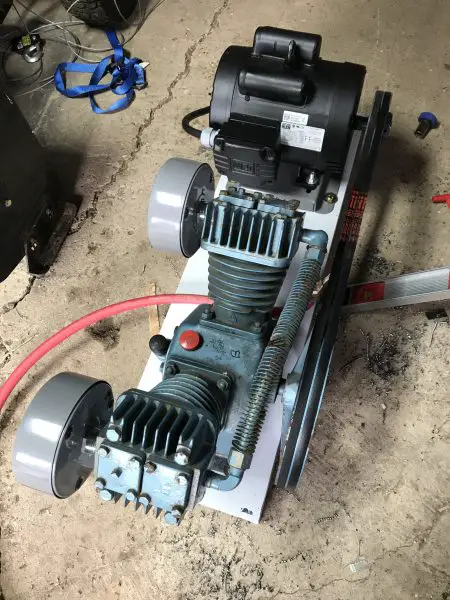
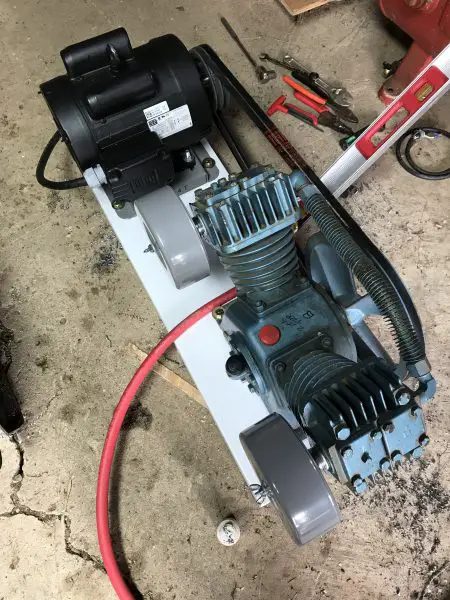
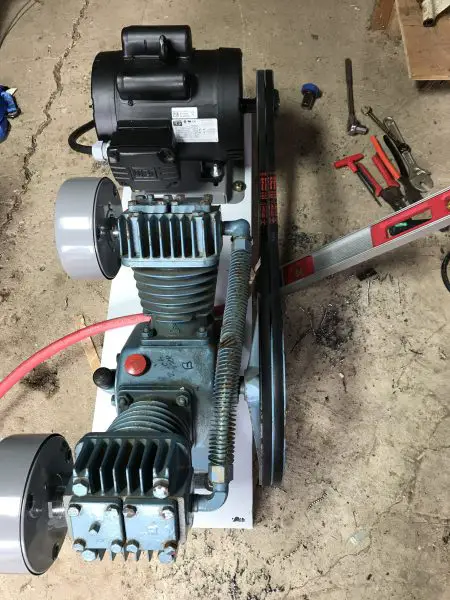
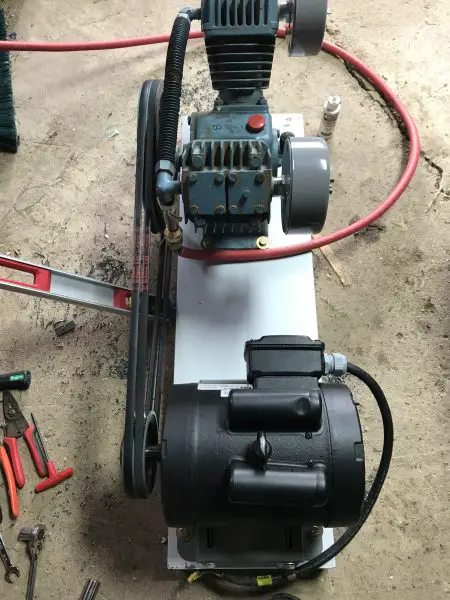
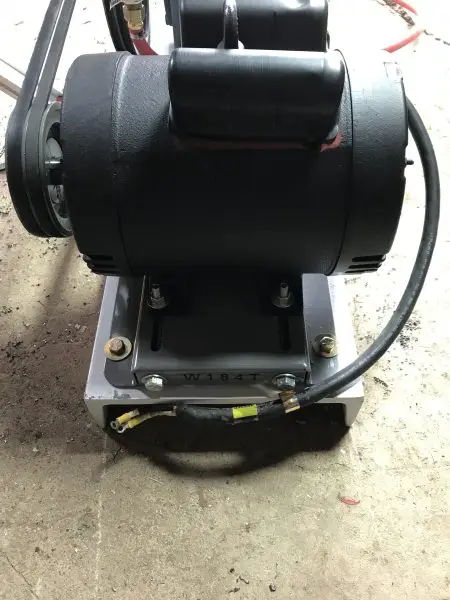
Troy adds:
“What size generator do you have?
On startup, your motor published amps times that by 10 and that is what it takes to get your motor spinning. You could install a tee between your discharge and tank with a ball valve so you have no pressure on start-up to reduce the head pressure until you get the motor to full speed.
Your generator needs to be 16,500 start-up and 6,000 running amps to start your 25amp electric motor. You can go on the web and search, there are examples where you take your amps then time it by the voltage to size your generator properly. Most homes have a 230volt 1phase breaker for use on a dryer you might see if you have. Hope this helps you out.”
Another issue from Zain:
“Weird. I presume my issue now, which I don’t understand because it ran it last week, is that the generator doesn’t have enough output to run this pump. It’s a 5500 continuous, 6500 cranking watt generator. That should be up to 27ish amps at 240V.
GRRR.”
Doug adds:
“As Troy says, you’re hard put to get a generator that’ll run a compressor of this size.
How far is the main service from where the build is? If you can open the hinged cover (so we can see the breaker layout) and take a pic of it, and a close-up of the meter, we can probably figure out how to get 230 or whatever out there. Unless your place is more than 70 or so years old and never had a wiring upgrade…”
In response to Doug, Zain says:
“I’m actually going to unplug the dryer and use my 80-foot generator cord to power this when I need to use it. I ordered the correct plug today to replace my cord. It’s 8AWG so it should be fine, 30 amp breaker as well.
Side notes. House built in 1870, 150 amp service in the house. The garage, as I found out this past weekend, has a 20 amp breaker, 120, on 10/2 direct burial feed from the house. Pretty sure that breaker is oversized…”
Doug:
“What? 20A on 10/2? How long is the run, and does it have a ground wire?
The dryer and 8ga should work…”
Zain says to Doug:
“I will worry about the power in the garage at a later time. It’s been that way since before we bought the place 6 years ago.
The dryer plug worked fine with the 80-foot cord I have. The pump started just fine, even at 120PSI in the tank. Starts instantly with zero hesitation.
My only concern is the knock that is emanating from the pump. It seems to get louder or more noticeable at 100PSI+ and the pump gets warm/hot. Please hear the attached audio file.
https://drive.google.com/file/d/13-Gk_KMaQGHHwPB-CjVxgvdOQ6A0PB13/view?usp=drivesdk
Thanks for the lessons here.
-Zain”
FAQs (Frequently Asked Questions)
To calculate what size pulley you need for your compressor in layman terms, simply divide the RPM of the pump by the RPM of the motor to get the required pulley ratio. You can now use this pulley ratio to determine either the pump or motor pulley if you have the other. For example, to calculate the motor pulley, you would multiple the pump pulley by the pulley ratio.
To calculate the pulley diameter of the motor you will need to use the RPM of the motor and pump, along with the diameter of the pump. The pulley diameter of the motor is equal to the diameter of the pump multiplied by its RPM, all divided by the RPM of the motor.
A smaller pulley turns a large one slower, but with more power available. For example, in large commercial trucks, a higher gear would have a slower turning engine but faster-turning wheels, resulting in increased speed. In contrast, a bigger drive pulley will cause the smaller one to turn much faster than the bigger one, and provide less power, and less speed.
If you have any questions regarding air compressor motor pulley sizing, please leave a comment below, with a photo if applicable, so that someone can help you!

